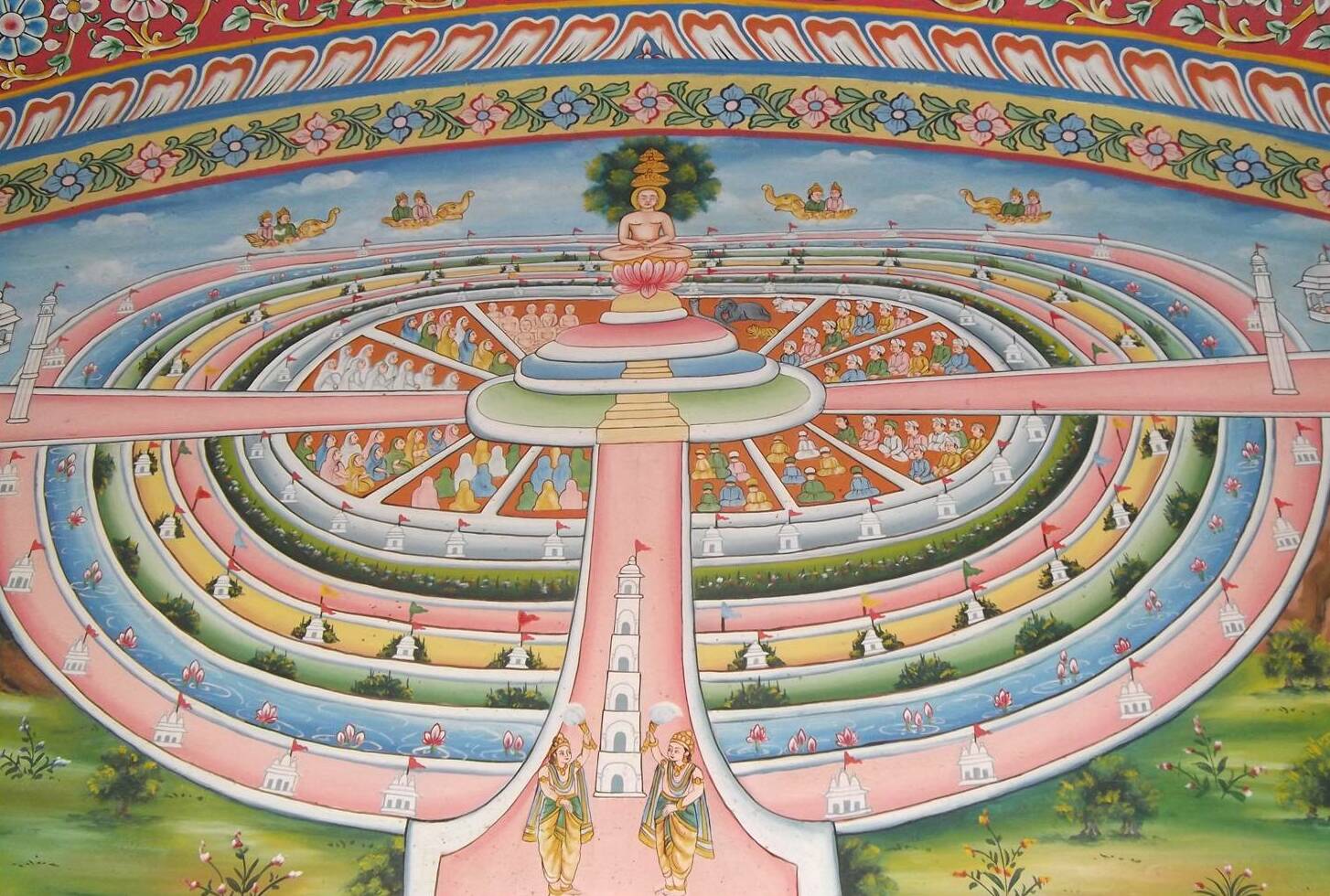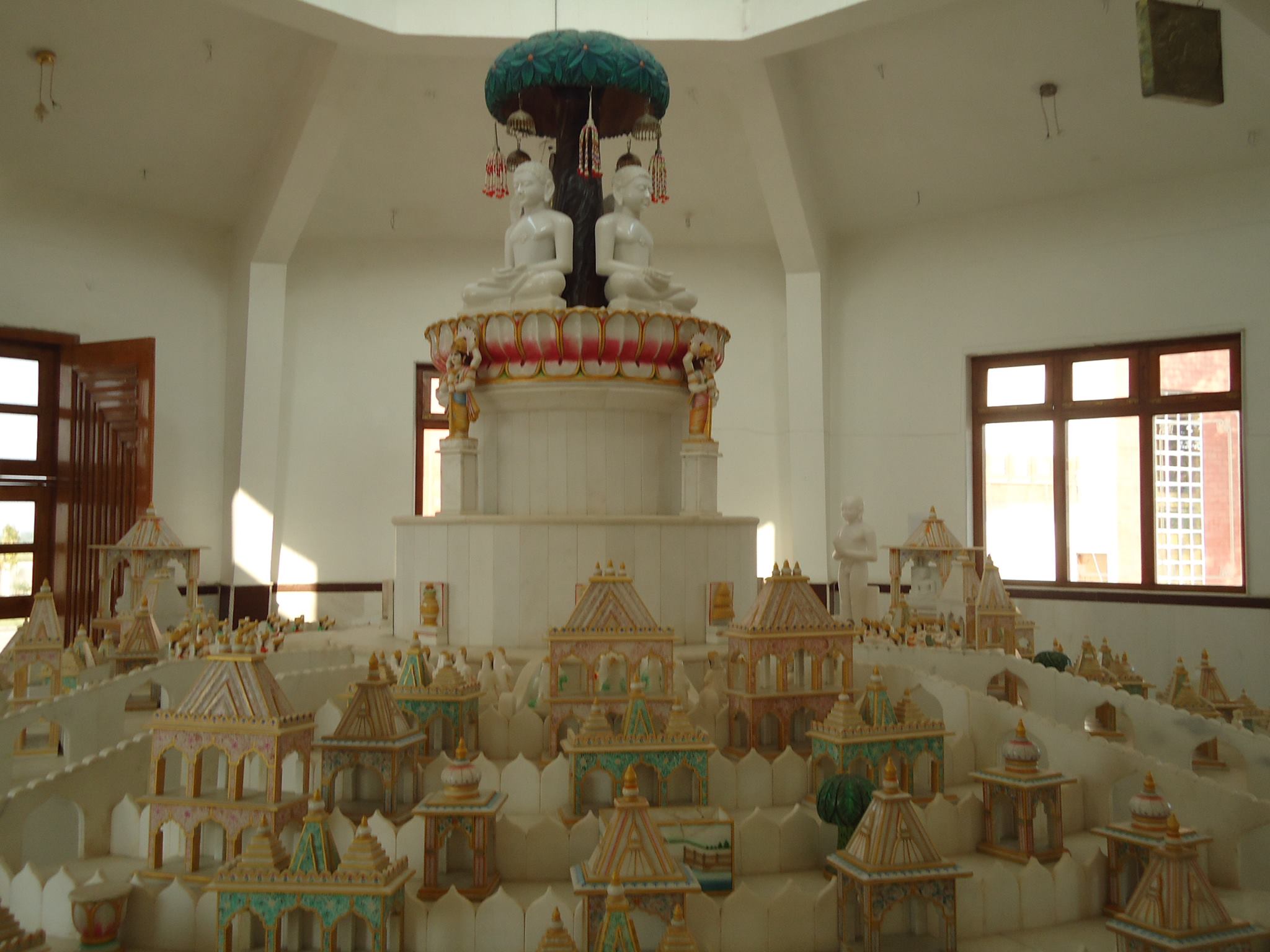Samavasarana on:
[Wikipedia]
[Google]
[Amazon]
 In
In
 In samavasarana hall, the ''tirthankara'' sits on a throne without touching it (about two inches above it). Around the tirthankara sit the '' ganadharas'' (chief disciples). Living beings sit in the following order:
*In the first hall, ascetics
*In the second hall, one class of deva ladies
*In the third hall, '' aryikas'' (nuns) and laywomen
*In the next three halls, three other classes of deva ladies
*In the next four halls, the four classes of devas (heavenly beings)
*Men, in the eleventh hall
*Animals, in the last hall
According to Jain texts, there would be four wide roads with four huge columns, Manasthamba (literally, pride pillar), one in each side. The total size of the hall varies depending upon the height of the people in that era. The size of
In samavasarana hall, the ''tirthankara'' sits on a throne without touching it (about two inches above it). Around the tirthankara sit the '' ganadharas'' (chief disciples). Living beings sit in the following order:
*In the first hall, ascetics
*In the second hall, one class of deva ladies
*In the third hall, '' aryikas'' (nuns) and laywomen
*In the next three halls, three other classes of deva ladies
*In the next four halls, the four classes of devas (heavenly beings)
*Men, in the eleventh hall
*Animals, in the last hall
According to Jain texts, there would be four wide roads with four huge columns, Manasthamba (literally, pride pillar), one in each side. The total size of the hall varies depending upon the height of the people in that era. The size of
 In samavasarana, a tirthankara sits facing the east, but appears to be looking in all directions. Tirthankara sits on a soft cushion while preaching the
In samavasarana, a tirthankara sits facing the east, but appears to be looking in all directions. Tirthankara sits on a soft cushion while preaching the
Jain manuscript page with Mahavira teaching to all creatures, western India, c. 1500-1600, gouache on paper, HAA.jpg, Jain manuscript page with Mahavira teaching to all creatures in Samavasarana, western India, c. 1500–1600, gouache on paper
Samosarana Mysore.jpg, Samavsarana of Mahavira as depicted in 19th-century art from Mysore.
Samavasarana painting from 1800 AD Rajasthan.jpg, Painting of Samavasarana (Assembly hall) of a Jain Tirthankara. It depicts various beings who come to hear the preachings of the Jina peacefully
Samosharan.jpg, Samosharan depiction
Article with Picture of Samavasarana
Jain philosophical concepts Jain belief and doctrine {{Jainism-stub
 In
In Jainism
Jainism ( ), also known as Jain Dharma, is an Indian religion. Jainism traces its spiritual ideas and history through the succession of twenty-four tirthankaras (supreme preachers of ''Dharma''), with the first in the current time cycle being ...
, Samavasarana or Samosharana ("Refuge to All") is the divine preaching hall of the Tirthankara
In Jainism, a ''Tirthankara'' (Sanskrit: '; English language, English: literally a 'Ford (crossing), ford-maker') is a saviour and spiritual teacher of the ''Dharma (Jainism), dharma'' (righteous path). The word ''tirthankara'' signifies the ...
, stated to have more than 20,000 stairs in it. The word ''samavasarana'' is derived from two words, ''sama'', meaning general and ''avasara'', meaning opportunity. It is an important feature in Jain art. The Samavasarana seems to have replaced the original Jain stupa
The Jain stupa was a type of stupa erected by the Jains for devotional purposes. A Jain stupa dated to the 1st century BCE-1st century CE was excavated at Mathura in the 19th century, in the Kankali Tila mound.
Jain legends state that the earli ...
as an object of worship.
Samavasarana Hall
 In samavasarana hall, the ''tirthankara'' sits on a throne without touching it (about two inches above it). Around the tirthankara sit the '' ganadharas'' (chief disciples). Living beings sit in the following order:
*In the first hall, ascetics
*In the second hall, one class of deva ladies
*In the third hall, '' aryikas'' (nuns) and laywomen
*In the next three halls, three other classes of deva ladies
*In the next four halls, the four classes of devas (heavenly beings)
*Men, in the eleventh hall
*Animals, in the last hall
According to Jain texts, there would be four wide roads with four huge columns, Manasthamba (literally, pride pillar), one in each side. The total size of the hall varies depending upon the height of the people in that era. The size of
In samavasarana hall, the ''tirthankara'' sits on a throne without touching it (about two inches above it). Around the tirthankara sit the '' ganadharas'' (chief disciples). Living beings sit in the following order:
*In the first hall, ascetics
*In the second hall, one class of deva ladies
*In the third hall, '' aryikas'' (nuns) and laywomen
*In the next three halls, three other classes of deva ladies
*In the next four halls, the four classes of devas (heavenly beings)
*Men, in the eleventh hall
*Animals, in the last hall
According to Jain texts, there would be four wide roads with four huge columns, Manasthamba (literally, pride pillar), one in each side. The total size of the hall varies depending upon the height of the people in that era. The size of Rishabha
Rishabhanatha, also ( sa, ऋषभदेव), Rishabhadeva, or Ikshvaku is the first (Supreme preacher) of Jainism and establisher of Ikshvaku dynasty. He was the first of twenty-four teachers in the present half-cycle of time in Jain c ...
deva's samavasarana was .
Effects
 In samavasarana, a tirthankara sits facing the east, but appears to be looking in all directions. Tirthankara sits on a soft cushion while preaching the
In samavasarana, a tirthankara sits facing the east, but appears to be looking in all directions. Tirthankara sits on a soft cushion while preaching the Jain philosophy
Jain philosophy refers to the ancient Indian philosophical system found in Jainism. One of the main features of Jain philosophy is its dualistic metaphysics, which holds that there are two distinct categories of existence, the living, conscio ...
in plain terms. All human
Humans (''Homo sapiens'') are the most abundant and widespread species of primate, characterized by bipedalism and exceptional cognitive skills due to a large and complex brain. This has enabled the development of advanced tools, culture, ...
s and animal
Animals are multicellular, eukaryotic organisms in the Kingdom (biology), biological kingdom Animalia. With few exceptions, animals Heterotroph, consume organic material, Cellular respiration#Aerobic respiration, breathe oxygen, are Motilit ...
s can understand the discourse. Jain scriptures say that all creatures who listen would become less violent and less greedy. The speech of the tirthankara is distinctly heard by every one present.
Gallery
See also
* God in JainismReferences
Citation
Source
* * * *Further reading
*External links
Article with Picture of Samavasarana
Jain philosophical concepts Jain belief and doctrine {{Jainism-stub